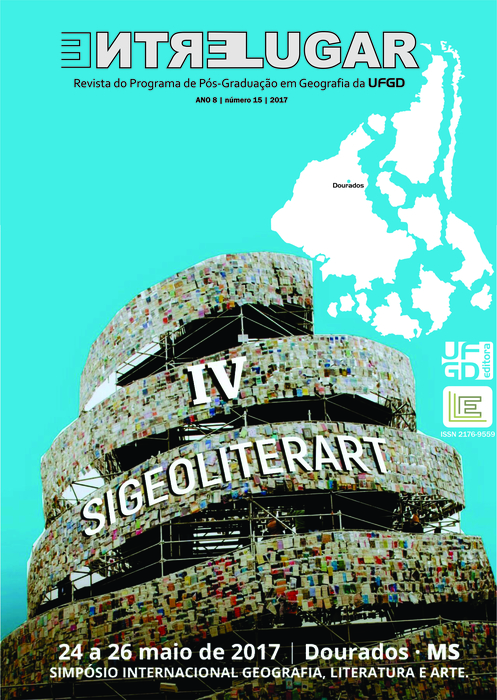When geography meets art: the esthetic of the Baroque Rio de Janeiro
DOI:
https://doi.org/10.30612/el.v8i15.7506Keywords:
City, Literature, RepresentationAbstract
Th is article presents a step of the “Geo-literary Ways: old and new regards
that meet each other” project that intends to research and to analyses the aesthetic of Rio de Janeiro baroque. It is about an innovative educational proposal and a didactic-pedagogical action involving the disciplines geography and literature, accomplished by two institutions directed to teaching activity, the UFRRJ - Agricultural Federal University of Rio de Janeiro and the State College - Amaro Cavalcanti. Th e project tries to think about the representations of the city of Rio de Janeiro taking as reference the literary writers with young students of Average Education and make them consider the interaction between real and fi ctional spaces from readings and fi elds works in the geo-literary ways inspired by the fi ctional spaces of the selected works. Our desire is to breach with the linear and segmented study on the urban Carioca and to understand the artistic one – in the manifestations of literature, painting or architecture – as being it proper object of geographic study.
Downloads
References
ABREU, M. A evolução Urbana do Rio de Janeiro. Rio de Janeiro: IPLAN- RIO/Zahar. 1987.
___ Geografia Histórica do Rio de Janeiro (1502-1700), 2 vols. Rio de Janeiro: Andrea Jakobsson Estúdio & Prefeitura do Município do Rio de Janeiro, 2010, 420 p. + 484 p.; il. color. ISBN: 978-85-88742-45-1 (vol. 1); ISBN: 978-85-88742-46-8 (vol. 2)
BRASIL. Secretaria de Educação Fundamental. Parâmetros Curriculares Nacionais: Ensino Médio. – Brasília: MEC/2000. Consulta ao site em 02/04/17 http://portal.mec.gov.br/seb/arquivos/pdf/cienciah.pdf.
BAKHTIN, M. Questões de Literatura e Estética. São Paulo: Hucitec, 1993.
___ Le probleme de contenu, du materiau et de la forme dans l’oeuvre littéraire. Esthétique et théorie du roman. Paris: Gallimard, pp. 21-82, 1978.
BERDOULAY, V. Des mots et des lieux. La dynamique du discours géographique. Paris: CNRS, 1988.
BERDOULAY, V.; ENTRIKIN, N. Lieu et sujet, Perspectives théoriques. L’espace géographique, n. 2, pp. 111-121, 1998.
BROSSEAU, M. Des romans-geographes. Paris: L’Harmattan, 1996.
___. L’espace littéraire en l’absence de description: um défi pour l’interpretation géographique de la littérature. Cahiers de géographie du Québec, v. 52, n.147, dez 2008.
CAVALCANTI, Lana. (Org.) Uma geografia da cidade: elementos da produção do espaço urbano. In: Geografia da cidade: a produção do espaço urbano em Goiânia. Goiânia. GO. Alternativa, 2001.
CHIAMPI, Irlemar. Barroco e modernidade: ensaios sobre literatura latino-americana. São Paulo: Perspectiva/FAPESP,1998.
CLAVAL, P. La géographie et la perception de l’espace . L’Espace Géographique. tomo 3 n. 3, pp. 179-187, Paris ,1974.
___. Les langages de la geographie et le rôle du discours dans son évolution, Annales de Geographie, t. 93, n. 518, pp. 409-422. Paris, 1984.
___. Le thème régional dans la littérature française. L’Espace Géographique. tomo 16 n. 1, pp. 60-73, 1987.
___. A evolução recente da geografia cultural de língua francesa. Tradução de Margareth de Castro A. Pimenta. Geosul, v.18, n. 35, pp. 7-25, jan/jun 2003.
FREIRE, Paulo. Pedagogia da autonomia. São Paulo: Editora Paz e Terra, 1996.
LEVY, B. Géographie culturelle, géographie humaniste et litterature: position épistémologique et métodologique. Géographie et Cultures, n. 21, pp. 27-44, primavera de 1997.
___. Gèneve, Ville Littéraire: de la Topophobie a la Topophilie. Revue Des Sciences Humaines (RSH), Paris, 284, out-dec, pp. 1135-149, 2006a.
___. Géographie et Littérature. Une Synthèse Historique. Le Globe, t.146, pp. 25-52, 2006b.
MELLO, J. B. F. de. Geografia humanística: a perspectiva da experiência vivida e uma crítica radical ao positivismo. Revista Brasileira de Geografia. n. 52(4) pp. 91-115 out/dez 1990.
___. Descortinando e (re)pensando categorias espaciais com base na obra de Yi-fu Tuan. Matrizes da Geografi a Cultural. Rio de Janeiro: Eduerj, 2001. (Trabalho apresentado no segundo Simpósio Nacional sobre Espaço e Cultura realizado em outubro de 2000 na UERJ).
NORONHA SANTOS, F. A. As Freguesias do Rio Antigo. Rio de Janeiro: O Cruzeiro, 1965.
TODOROV, T. Téories du symbole. Paris: Seuil, 1977.
___. La notion de littérature et autres essais. Paris: 1987.
___. Poética da Prosa. São Paulo: Martins Fontes, 2003.
TUAN, Yi-Fu. Literature, experience and environmental knowing. In: MOORE, G.T.; GOLLEDGE, R. G. (ed.) Environmental knowing: theories, research and methods. Stroudsburg: Dowden, Hutchinson and Ross, pp. 260 - 272, 1976.
___. Literature and Geography: implications for geographical research. In: LEY, David; SAMUELS, Marwyn S. Humanistic Geography: prospects and problems. Chicago: Maroufa Press, pp. 194-206, 1978.
___. Topofilia: um estudo da percepção, atitudes e valores do meio ambiente. (tradução de Lívia de Oliveira), São Paulo: Difel, 1980[1974].
___. Espaço e lugar: a perspectiva da experiência. (tradução de Lívia de Oliveira), São Paulo: Difel, 1983[1977].
___. A Geografia Humanística. In: CHRISTOFOLETTI, A. (org). Perspectivas da Geografia. São Paulo: Difel, cap. 7, pp. 143-164, 1982.
___. Paisagens do medo. São Paulo: UNESP, 2006.
Downloads
Published
How to Cite
Issue
Section
License
Autores que publicam nesta revista concordam com os seguintes termos:
- Autores mantém os direitos autorais e concedem à revista o direito de primeira publicação, com o trabalho simultaneamente licenciado sob a Creative Commons Atribuição-NãoComercial-CompartilhaIgual 3.0 Brasil que permitindo o compartilhamento do trabalho com reconhecimento da autoria do trabalho e publicação inicial nesta revista.
- Autores têm autorização para assumir contratos adicionais separadamente, para distribuição não-exclusiva da versão do trabalho publicada nesta revista (ex.: publicar em repositório institucional ou como capítulo de livro), com reconhecimento de autoria e publicação inicial nesta revista.
- Autores têm permissão e são estimulados a publicar e distribuir seu trabalho online (ex.: em repositórios institucionais ou na sua página pessoal) a qualquer ponto antes ou durante o processo editorial, já que isso pode gerar alterações produtivas, bem como aumentar o impacto e a citação do trabalho publicado (Veja O Efeito do Acesso Livre).




